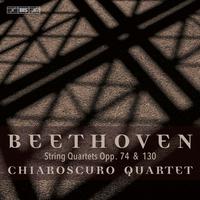
Beethoven: String Quartets Nos. 10 & 13, Opp. 74 & 130
After the six Op. 18 quartets, the much-acclaimed Chiaroscuro Quartet now turns to two masterpieces from Beethoven’s middle and late periods. String Quartet No. 10 in E flat major, Op. 74, nicknamed ‘Harp’ because of the abundant pizzicati in its first movement, comes across as a genial and unproblematic work that was very well received immediately upon publication and has remained one of the composer’s best-loved quartets. String Quartet No. 13 in B flat major, Op. 130, is in a very different vein. Belonging to the series of so-called ‘late’ quartets composed between 1824 and 1826, it is a six-movement structure modelled on an eighteenth-century divertimento, adding two movements to the traditional four-movement scheme: an Alla danza tedesca and a Cavatina. Despite its evocation of an archaic dance, the Alla danza tedesca is typically Beethovenian, with its original treatment of dynamics. The Cavatina, which moved the composer to tears during its composition, is a lyrical and moving piece. Beethoven had intended to conclude this imposing work with a large-scale fugue, but its boldness baffled his first listeners and, at the request of his publisher, he resorted instead to a more approachable movement presenting a mixture of laconic dryness and, in places, tender lyricism.
